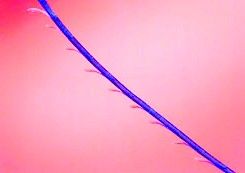
What is Barbed Suture?
Barbed suture is a self anchoring suture at approximately every 1 mm of tissue. In barbed suture there is a uniform distribution of wound tension across the suture line than with conventional running smooth suture, yielding more consistent wound opposition without the trouble and required skill of tying a knot. Barbed sutures are recently available in a variety of form for minimal access surgery both absorbable and non-absorbable monofilament materials. It is made by fine laser cut on variety of suture material. Advantage is that surgeon does not need to tie a knot. Bidirectional barbed sutures are manufactured from monofilament fibers via a micro machining technique that cuts barbs into the suture around the circumference in a helical pattern. The barbs are separated from one another by a distance of 0.88 to 0.98 mm and are divided into 2 groups that face each other in opposing directions from the suture midpoint. Specifically, currently available bidirectional and unidirectional barbed suture materials include PDO, polyglyconate, poliglecaprone 25, glycomer 631, nylon, and polypropylene.
Stitches and surgery treatment have been linked together since the first functions were conducted. Throughout the history of minimal access surgery treatment, the wide range of components used to close wound has involved suture of silver, silver, metal, and steel; dry gut; silk; hairs; shrub debris and other flower fibers; and, more lately, many artificial arrangements. Despite the wide range of different techniques conducted with a wide range of different injure closing biomaterials; no research or physician has yet determined the perfect suture for all circumstances. In the past few years, a new type of suture material called barbed suture has been presented into the surgeon’s armamentarium. Currently, there are 2 over the counter available spiked suture products: the Quill™ SRS bidirectional spiked suture products (Angiotech Medication, Inc., Calgary, BC, Canada) and the V-Loc™ Absorbable Wound Closure System products (Covidien, Mansfield, MA). These artificial sutures avoid the conventional, sleek, knot-requiring attribute of sutures in support of hook varieties that provide to core the sutures to cells without troubles.
Where are the classification and characteristic of suture materials?
Suture material can be classified by numerous different characteristics. For practical purposes, the 6 categories of suture classification believed to best assist surgeons in choosing the proper suture material fortheir surgeries are:
- Suture size
- Tensile strength
- Absorbable versus non absorbable
- Multi filament versus monofilament
- Stiffness and flexibility
- Smooth versus barbed
Each suture material which is used in surgery has a recognized tensile strength which, for a given suture size, is most easily discussed as its failure or break load. This is the amount of weight in pounds or kilograms that is necessary for the fibres of suture to cause tension and the suture to rupture. Typically, this measurement is presented in 2 forms, one is straight pull and another is knot pull, to reflect the reduction in any given suture’s strength when it is knotted during laparoscopic surgery. In practical terms, the knot-pull tensile strength most accurately reflects a given smooth suture’s in vivo tissue holding capacity because almost all minimal access surgical applications for smooth suture require knotting. In a straight-pull tensile test, tension to rupture is applied at either end of a suture. A knot-pull tensile test is the same except that a single knot has been tied in the middle of the strand.
Unlike conventional suture an exception, barbed suture strengths are reported only as straight pull because there is no knot is required in barbed suture. All these measurements are reported as in vitro values and reflect only the suture’s immediate, out-of-the-package strength without regard for the tissue milieu in which they will be placed.
Why knot is not tied?
It is difficult for many laparoscopic surgeons to think about suture material without an accompanying good quality extra corporeal or intra corporeal knot. At World Laparoscopy Hospital we have used barbed suture in many gynecological and general surgery. Although the laparoscopic surgical knot used with a length of smooth sutures is a significant necessary that is accepted worldwide as the only ideal means to anchor suture material within a wound, but now time has come surgeon should rely on barbed suture.
A laparoscopic knot-secured, smooth suture inevitably creates an uneven distribution of tension across the surgical wound. The closed margin of a wound may be that of equal tension distribution, there are unequal tension burdens placed on the knots rather than on the length of the suture line in laparoscopic surgery. This tension gradient across the surgical wound may subtly interfere with uniform healing and remodeling.
When laparoscopic surgeon first faced with newer barbed sutures, many laparoscopic surgeons are initially very much skeptical with regard to the strength of the knotless, barbed suture lines as compared with traditional knotted because they fear it will not hold, smooth suture lines. Although the data are limited and almost exclusively based on studies with bidirectional barbed suture, barbed suture lines appear to be at least as strong if not more stronger than traditional laparoscopic intra corporeal knotted, smooth suture lines. Conventional sutures lose tensile strength sometime at and around the laparoscopic knots, the knotless, barbed suture is not subject to this hazard. This is clearly evident in vitro in a comparison of the straight-pull strengths of barbed sutures versus the knot-pull strengths of their smooth suture equivalent. In a recent study of porcine gastrointestinal closure burst-strength pressures in wounds closed with barbed suture were no different than repairs performed with traditional laparoscopic surgery knotted, smooth suture lines.
At present barbed suture is a relatively new but exciting addition in minimal access surgery to the variety of suture materials. As experience grows with barbed sutures in laparoscopic surgery, more applications for its minimal access surgical use will likely arise.
World Laparoscopy Hospital, Cyber City, DLF Phase II, Gurugram, NCR Delhi, 122 002, India
PHONES:
For Training: +919811416838
For Treatment: +919811912768
For General Enquiry: +91(0)124 - 2351555





